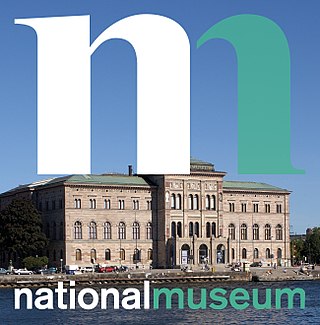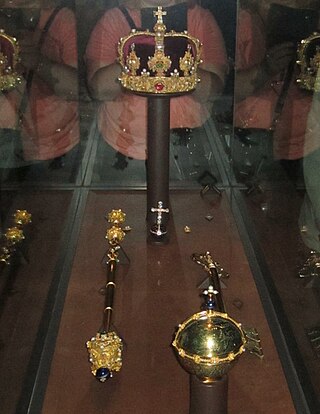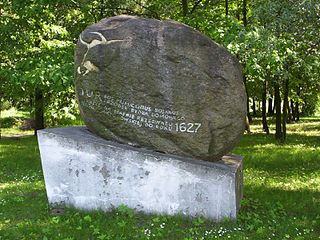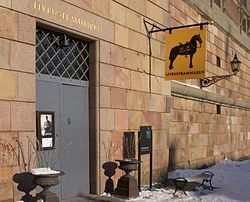
Charles XIII, or Carl XIII, was King of Sweden from 1809 and King of Norway from 1814 to his death. He was the second son of King Adolf Frederick of Sweden and Louisa Ulrika of Prussia, sister of Frederick the Great.

The monarchy of Sweden is centred on the monarchical head of state of Sweden, by law a constitutional and hereditary monarchy with a parliamentary system. There have been kings in what now is the Kingdom of Sweden for more than a millennium. Originally an elective monarchy, it became a hereditary monarchy in the 16th century during the reign of Gustav Vasa, though virtually all monarchs before that belonged to a limited and small number of political families which are considered to be the royal dynasties of Sweden.

The early Vasa era is a period in Swedish history that lasted between 1523–1611. It began with the reconquest of Stockholm by Gustav Vasa and his men from the Danes in 1523, which was triggered by the event known as the Stockholm Bloodbath in 1520, and then was followed up by Sweden's secession from the Kalmar Union, and continued with the reign of Gustav's sons Eric XIV, John III, John's son Sigismund, and finally Gustav's youngest son Charles IX. The era was followed by a period commonly referred to as the Swedish Empire, or Stormaktstiden in Swedish, which means "Era Of Great Power".

Jacob Johan Anckarström was a Swedish military officer who is known as the assassin of King Gustav III of Sweden. He was convicted and executed for regicide.

Stockholm Palace or the Royal Palace is the official residence and major royal palace of the Swedish monarch. Stockholm Palace is in Stadsholmen, in Gamla stan in the capital, Stockholm. It neighbours the Riksdag building. The offices of the King, the other members of the Swedish royal family, and the Royal Court of Sweden are here. The palace is used for representative purposes by the King whilst performing his duties as the head of state.

The Deluge was a series of mid-17th-century military campaigns in the Polish–Lithuanian Commonwealth. In a wider sense, it applies to the period between the Khmelnytsky Uprising of 1648 and the Truce of Andrusovo in 1667, comprising the Polish theatres of the Russo-Polish and Second Northern Wars. In a stricter sense, the term refers to the Swedish invasion and occupation of the Commonwealth as a theatre of the Second Northern War (1655–1660) only; in Poland and Lithuania this period is called the Swedish Deluge, or less commonly the Russo–Swedish Deluge due to the simultaneous Russo-Polish War. The term "deluge" was popularized by Henryk Sienkiewicz in his novel The Deluge (1886).

Catherine Jagiellon was a Polish–Lithuanian Commonwealth princess and Queen of Sweden from 1569 as the wife of King John III. Catherine had significant influence over state affairs during the reign of her spouse. She negotiated with the pope to introduce Counter-Reformation in Sweden. She was the mother of Sigismund, King of Poland (1587-1632) and Sweden (1592-1599).

Gripsholm Castle is a castle in Mariefred, Södermanland, Sweden. It is located by lake Mälaren in south central Sweden, in the municipality of Strängnäs, about 60 km west of Stockholm. Since Gustav Vasa, Gripsholm has belonged to the Swedish Royal Family and was used as one of their residences until the 18th century. It is now a museum, but is still considered to be a palace at the disposal of the King and as such it is part of the Crown palaces in Sweden.

Nationalmuseum is the national gallery of Sweden, located on the peninsula Blasieholmen, in central Stockholm.

Slottsbacken is a street in Gamla stan, the old town in central Stockholm, Sweden.

Sweden's regalia are kept deep in the vaults of the Royal Treasury, underneath the Royal Palace in Stockholm, in a museum that is open to the public. The crowns and coronets have not been worn by Swedish royalty since 1907, but they are still displayed at weddings, christenings and funerals.
KunzLochner was an eminent master plate armourer, blacksmith and silversmith from Nuremberg, Germany, Holy Roman Empire. He was the son of a skillful armourer with the same name, and his two brothers Heinrich and Hans who were also skillful armourers and blacksmiths. In 1543, Lochner started working for the Holy Roman Emperor Ferdinand I, and the following year he began his service at the future Maximilian II as court armourer. Lochner's workshop produced some of the most magnificent plate armours made during the 16th-century Renaissance period for field warfare, tourney and ceremonial occasions. Lochner's patrons included royalty, knights and nobility from across Europe.

Jaktorów is a village in Grodzisk Mazowiecki County, Masovian Voivodeship, in east-central Poland. It is the seat of the gmina called Gmina Jaktorów. It lies approximately 8 kilometres (5 mi) west of Grodzisk Mazowiecki and 37 km (23 mi) southwest of Warsaw.

Gustav III ,note on dates also called Gustavus III, was King of Sweden from 1771 until his assassination in 1792. He was the eldest son of King Adolf Frederick and Queen Louisa Ulrika of Sweden.

Ulrika "Ulla" Eleonora von Höpken, later von Wright, née von Fersen, was a Swedish countess and courtier. She is also famous in history as one of "the three graces" of the Gustavian age; three ladies-in-waiting immortalized in the poem Gracernas döpelse by Johan Henric Kellgren. She was a leading socialite and trendsetter in contemporary Sweden, and one of the best known personalities of the Gustavian age.

Events from the year 1772 in Sweden

Several Swedish coronation robes from the 16th to the 19th century are preserved at The Royal Armoury in Stockholm, Sweden. The youngest one, Oscar II's coronation robe from 1873, is in the Treasury at Stockholm Palace.

The wedding between Gustav II Adolf of Sweden and Maria Eleonora of Brandenburg took place at the Royal Castle on November 25, 1620.

The wedding between Crown Prince Gustav, later Gustav III of Sweden, and Princess Sophia Magdalena of Denmark took place on November 4, 1766 at The Royal Palace.

Events from the year 1628 in Sweden


























